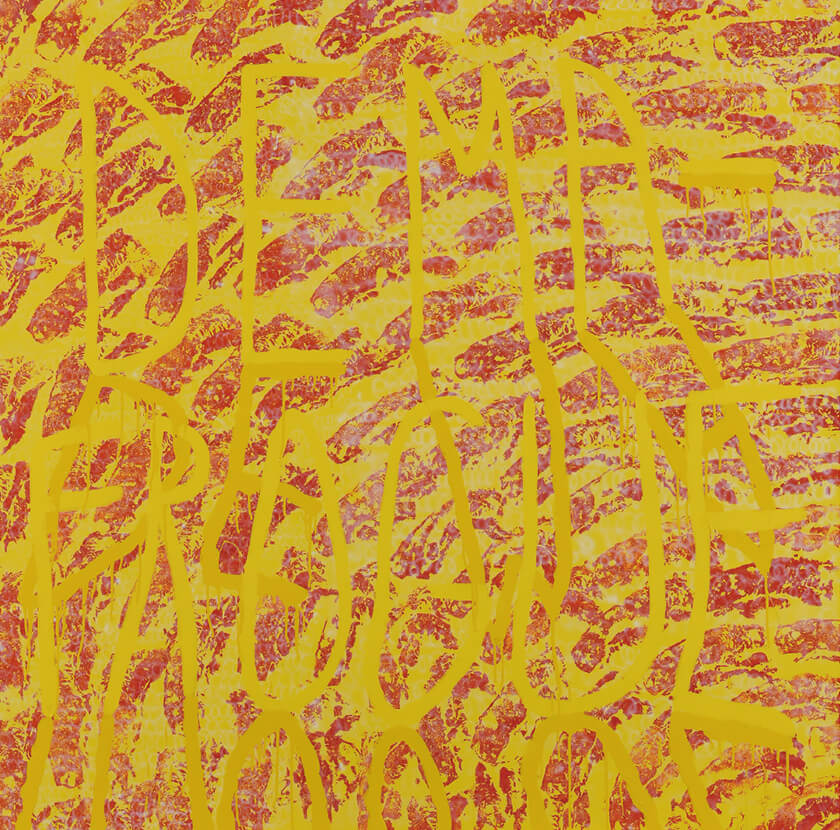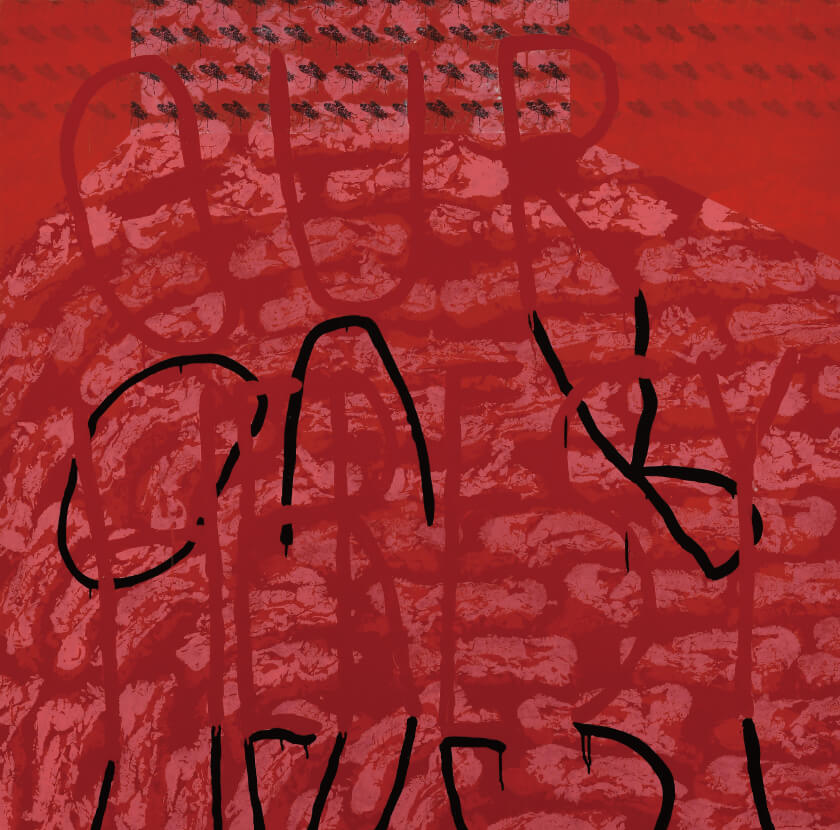Hyper Kitsch, Spiders Die on Their Backs – Composition 1
Hyper Kitsch, Spiders Die on Their Backs – Composition 1
The title takes on a poetic tone, literally
referring to the spider imagery within the space of the painting. Layered on top of the visual clutter of
the
surface, black enamel paint contours a suggested perspectival space while simultaneously engaging with its
plasticity. Conceptual navigation between title, illusionistic space, and material surface shapes the
participatory experience by the viewer.
Spiders Die on Their Backs – Composition 2
Spiders Die on Their Backs – Composition 2
In this composition, a gradient of black accentuates the
geometry
and illusionistic dimensionality of the suggested floating platform. While this spatial logic insinuates the
existence of a vanishing point when the painting is viewed from a distance, the matte surface of the meat
prints, spray paint, spider form, and drips of enamel remain flattened, thus re-contextualizing material
comportment as an equally important conceptual entry point into the painting.
Spiders Die on Their Backs – Composition 3
Spiders Die on Their Backs – Composition 3
Through the absence of the spider imagery while still
referring
to it in the title, the recurring motif of the monolithic platform in space puts emphasis on seemingly
metaphorical or allegorical overtones. The stark contrast in the visual operations between an
ethereal/fantastical space and a flattened material surface provokes an affective response, thus disrupting
the
narrative tone of the other two compositions; it promises then immediately frustrates meaning for the
viewer.
Push Me to the Edge
Push Me to the Edge
Both the title and text “ALL MY FRIEND ARE BREAD” reference the excerpt
from Lil Uzi
Vert’s song, XO Tour Llif3, “Push me to the edge, all my friends are dead.” The text within the painting,
meat
prints, and sharp black obliques disappear into a suggested perspectival vanishing point. While the “ALL MY
FRIENDS ARE BREAD” follows the perspectival logic of the space, the satirical gesture of turning “dead” to
“bread” theoretically dissociates itself from the rest of the visual logic and operations of the work,
especially having derived from an obscure pop cultural reference.


Demafrogue
Demafrogue
The word “DEMAFROGUE”, a pun taken from the term “demagogue,” dissolves within the field of
meat
prints that neither operate as a background nor foreground. “DEMAFROGUE” is further obscured within the
materiality and drips of its own mirrored shadow. Visual chaos thus creates tension between legibility,
semantics, and an affective experience with the surface.
Our Heresy
Our Heresy
The text “OUR HERESY”visually evaporates into the color field of the background. The black
shadow
of the text, in addition to the geometric blocks of red in the top corners, suggests a perspectival logic
that
is simultaneously contradicted by the paint drips. Scans of meats prints are used to contour the
silhouette
of
the flies, the only semiotic visual element in the work.

Demafrogue
Demafrogue
The word “DEMAFROGUE”, a pun taken from the term “demagogue,” dissolves within the field of
meat
prints that neither operate as a background nor foreground. “DEMAFROGUE” is further obscured within the
materiality and drips of its own mirrored shadow. Visual chaos thus creates tension between legibility,
semantics, and an affective experience with the surface.

Our Heresy
Our Heresy
The text “OUR HERESY”visually evaporates into the color field of the background. The black
shadow
of the text, in addition to the geometric blocks of red in the top corners, suggests a perspectival logic
that
is simultaneously contradicted by the paint drips. Scans of meats prints are used to contour the silhouette
of
the flies, the only semiotic visual element in the work.
FEAR OF DOG
FEAR OF DOG
Making a pun on the phrase, “Fear of God,” referring to one’s submission to a deity, insinuates a polemic
gesture of
heresy yet this insinuation is intentionally left poorly substantiated. The socio-politically loaded pun
itself
functions as the studium in which the visual language of surface plasticity gives rise to punctum.
The Ramen Devil
The Ramen Devil
This sculpture is artifact made to tribute the Ramen Devil, a fictitious deity based on
the
internet icon Filthyfrank. Make up of hundreds of layers of cardboard, the saber tooth tiger skull is
suspended
by a plexiglass plinth. The 3D model of the saber tooth tiger skull was sourced from an online 3D model
library,
thus the historical accuracy and origin of the skull model itself is unknown. The experience of navigating
the
around the museological presentation of the sculpture necessitates a spiritual engagement with the
quasi-archaeological object. The sculpture itself is invaluable as a historical reproduction, instead its
value
derives from its function as a shrine and a spiritual conduit for the “Ramen Devil.”


